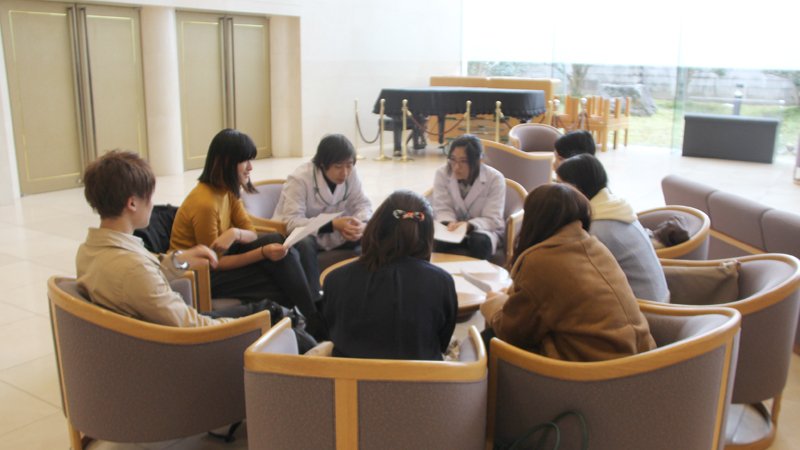
Discussing the video project proposal with student staff members.
Through my interviews and meetings, I was able to pick up and practice the many complex forms of keigo (honorific speech) depending on the relation between me and the person I was addressing. For example, I noticed that student staff members, even if the same age as me or “senpai”, would use the passive form keigo (sareru) with me – before, I had always assumed that simple -desu/masu would suffice. It took me some time to get it right, but I was finally able to reciprocate. Other forms, such as the complex “sasete-itadaku” and “shite-itadaku”, I learned in my regular language class, yet was given ample opportunities to put into use at my CIP. I also heard “-haru” used quite frequently, as friendly respectful language between colleagues or towards a junior member.
Aside from language, I also gained a more nuanced understanding of Japanese culture. Last week, I was told by Shiotari-san, a student staff member, that initially my superiors were surprised or even shocked at my proposal to make a promotional video, because Japanese people are not used to promoting themselves and instead prefer remaining “behind the scene”. Having lived for quite some time in the United States, where self-promotion is considered a virtue rather than vice, I was astonished. In another instance, I was invited to lunch by Li-san, an international student from China. I happily accepted, yet Li-san insisted that she “really” wanted to have lunch with me. I then learned that for many Japanese people, an invitation to lunch only serve as a perfunctory polite phrase to indicate that a conversation is finished; in China, any invitation to lunch would have to be genuine, otherwise it would be incredibly rude. Without my CIP, I would not have noticed these nuanced differences so quickly.
I started my CIP being extremely nervous and did not even dream that one day I would proudly call myself a member of the Museum community. Heading to a Japanese workplace setting when you are still learning the language can be a stressful experience, yet as long as you remain open-minded, are open to taking risks, take on initiatives and challenges, and are not afraid of making mistakes in daily speech or in your responsibilities, you will get there. My CIP has taught me keigo and nuances of Japanese culture, yet it has also challenged me to work harder and always strive for more, and for that I am grateful.

Hi Yupei!
It sounds like you had an amazing experience with your CIP, and really got to know your co-workers well! I’m so impressed that you’re able to use keigo so well, and that you’ve picked up on so many of the nuances!
Since you’ve been working at Ritsumeikan, I am assuming that you’ve gotten pretty familiar with Ritsumeikan, as well as Doshisha. Through your interactions there, have you noticed any differences in the university culture between the two schools?
Hi Elizabeth – thank you for your comment. For university cultures – not that I know of, since I’m mainly in a professional working environment in Ritsumeikan. However, both schools are fairly socially liberal, and focus quite heavily on international studies. 🙂
Yupei,
From your report, it seems that you gained a lot of experience blending into a working environment in Japan. Your video campaign project seems really awesome! I know you’re also doing koto for a CIP, and it seems that keigo is also the norm in that setting too. Are there any differences you find in peoples’ usages in these two different settings?
As for the lunch thing – haha, I totally relate! This also seems to be the case back at Yale too. Since making this discovery, have you figured out how to actually invite Japanese people out for a meal? (I sure haven’t haha..)
Hi Laurie – thank you for your comment! For koto, no-one uses Keigo as we all used Kansai-ben with each other (so, “haru”) :). As for how to actually invite Japanese people out for a meal, I feel like it’s something I need to work on, but just try to hint at them your interest in knowing them better without mentioning the meal, and let them do the invitation. 🙂